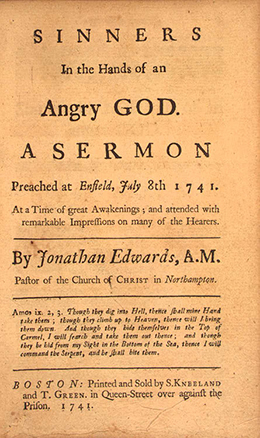
The Great Awakening
The First Great Awakening
During the 18th century, the British Atlantic experienced an explosion of Protestant revival known as the First Great Awakening (the Second Great Awakening occurred in the 19th century).
During the First Great Awakening, evangelists came from several denominations of Protestantism.
Congregationalists, Anglicans - members of the Church of England - and Presbyterians. They rejected seemingly sterile and formal forms of worship in favor of a strong emotional religion.
While Martin Luther and John Calvin preached the doctrines of predestination and Bible reading, new evangelical preachers spread a personal and experiential message of faith that goes beyond mere study of books. Individuals can bring about their own salvation by accepting Christ.
This is a particularly welcome message for those who feel excluded from traditional Protestantism.
Women, youth, people at the lower end of the social spectrum. The first great awakening caused a schism between those who followed the Gospel message - the New Light - and those who rejected it - the Old Light. dismissed the new revival as chaos.
A Protestant revival began in New Jersey, led by a pastor of the Dutch Reformed Church named Theodoros Frelinghuysen. Frelinghuysen's example influenced other clergy, including Gilbert Tennent of the Presbyterian Church.
Tennant helped revive Presbyterianism in the Middle Colonies, including Pennsylvania, New York, and New Jersey, and established seminaries to train other evangelical ministers.
The New Rights also founded colleges in Rhode Island and New Hampshire, which later became Brown University and Dartmouth College.
Jonathan Edwards and George Whitefield
Edwards`s best-known sermon, “Sinners in the Hands of an Angry God”, used powerful imagery to describe the terrors of hell and the possibilities of avoiding damnation by personal conversion. 
These new churches gained converts and competed with older Protestant groups like Anglicans, members of the Church of England; Congregationalists, the heirs of Puritanism in America; and Quakers. The influence of these older Protestant groups, such as the New England Congregationalists, declined because of the Great Awakening. .
The Great Awakening
The First Great Awakening
During the 18th century, the British Atlantic experienced an explosion of Protestant revival known as the First Great Awakening (the Second Great Awakening occurred in the 19th century).
During the First Great Awakening, evangelists came from several denominations of Protestantism.
Congregationalists, Anglicans - members of the Church of England - and Presbyterians. They rejected seemingly sterile and formal forms of worship in favor of a strong emotional religion.
While Martin Luther and John Calvin preached the doctrines of predestination and Bible reading, new evangelical preachers spread a personal and experiential message of faith that goes beyond mere study of books. Individuals can bring about their own salvation by accepting Christ.
This is a particularly welcome message for those who feel excluded from traditional Protestantism.
Women, youth, people at the lower end of the social spectrum. The first great awakening caused a schism between those who followed the Gospel message - the New Light - and those who rejected it - the Old Light. dismissed the new revival as chaos.
A Protestant revival began in New Jersey, led by a pastor of the Dutch Reformed Church named Theodoros Frelinghuysen. Frelinghuysen's example influenced other clergy, including Gilbert Tennent of the Presbyterian Church.
Tennant helped revive Presbyterianism in the Middle Colonies, including Pennsylvania, New York, and New Jersey, and established seminaries to train other evangelical ministers.
The New Rights also founded colleges in Rhode Island and New Hampshire, which later became Brown University and Dartmouth College.
Jonathan Edwards and George Whitefield
Edwards`s best-known sermon, “Sinners in the Hands of an Angry God”, used powerful imagery to describe the terrors of hell and the possibilities of avoiding damnation by personal conversion. 
These new churches gained converts and competed with older Protestant groups like Anglicans, members of the Church of England; Congregationalists, the heirs of Puritanism in America; and Quakers. The influence of these older Protestant groups, such as the New England Congregationalists, declined because of the Great Awakening. .
 Knowt
Knowt
